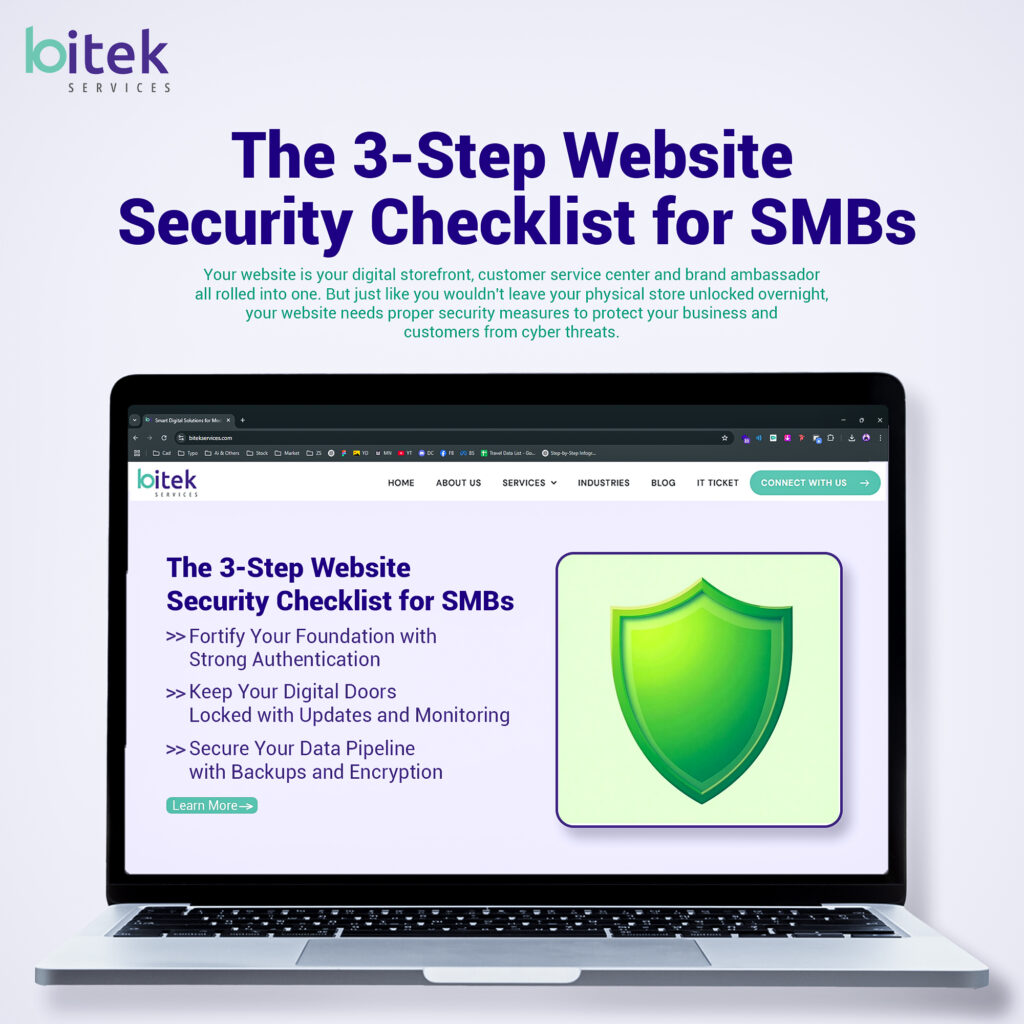Your website is your digital storefront, customer service center, and brand ambassador all rolled into one. But just like you wouldn’t leave your physical store unlocked overnight, your website needs proper security measures to protect your business and customers from cyber threats.
Small and medium-sized businesses (SMBs) are increasingly targeted by cybercriminals who view them as easier targets than large corporations with dedicated security teams. The good news? You don’t need a massive IT budget or technical expertise to significantly improve your website’s security posture.
Here’s a practical 3-step checklist that will transform your website from vulnerable to virtually bulletproof.
Step 1: Fortify Your Foundation with Strong Authentication
The Problem: Weak passwords and single-factor authentication are like leaving your front door key under the welcome mat. Over 80% of data breaches involve compromised credentials.
Your Action Plan:
Implement Multi-Factor Authentication (MFA) on all admin accounts. This adds an extra layer of security beyond just passwords. Even if someone steals your password, they’ll still need access to your phone or authentication app to get in.
Enforce strong password policies across your organization. Require passwords that are at least 12 characters long with a mix of uppercase, lowercase, numbers, and special characters. Better yet, encourage the use of password managers that generate and store unique passwords for every account.
Regularly audit user access. Remove inactive users immediately and ensure each person only has the minimum permissions needed for their role. Your content writer doesn’t need administrator privileges, and your web designer doesn’t need access to customer data.
Quick Win: Set up automatic logout after periods of inactivity. This prevents unauthorized access if someone walks away from their computer while logged in.
Step 2: Keep Your Digital Doors Locked with Updates and Monitoring
The Problem: Outdated software is like having a broken lock that everyone knows about. Cybercriminals actively scan for websites running outdated systems with known vulnerabilities.
Your Action Plan:
Enable automatic updates for your content management system (WordPress, Shopify, etc.), themes, and plugins. Most security breaches happen through outdated components, not the core platform itself. Set aside time monthly to manually check for any updates that require attention.
Install a web application firewall (WAF). Think of this as a security guard that screens every visitor before they reach your website. Many hosting providers offer built-in WAF solutions, or you can use services like Cloudflare’s free tier.
Set up security monitoring and alerts. Use tools that notify you immediately when suspicious activity occurs. This includes failed login attempts, file changes, or unusual traffic patterns. The faster you know about a problem, the quicker you can respond.
Perform regular security scans. Schedule weekly automated scans to check for malware, vulnerabilities, and suspicious files. Many security plugins offer this feature, or you can use online tools like Sucuri or Wordfence.
Pro Tip: Create a staging environment where you can test updates before applying them to your live site. This prevents updates from breaking your website functionality.
Step 3: Secure Your Data Pipeline with Backups and Encryption
The Problem: Even with perfect security, disasters happen. Hardware fails, human errors occur, and sophisticated attacks sometimes succeed. Without proper backups and encryption, these events can destroy your business.
Your Action Plan:
Implement the 3-2-1 backup rule: Maintain 3 copies of your data, stored on 2 different types of media, with 1 copy stored offsite. Automate daily backups and test restore procedures monthly. A backup you can’t restore is worthless.
Encrypt sensitive data both in transit and at rest. Ensure your website uses HTTPS (SSL/TLS certificates) for all pages, not just checkout or login pages. This encrypts data traveling between your website and visitors’ browsers.
Secure your hosting environment. Choose a reputable hosting provider that offers security features like DDoS protection, malware scanning, and isolated server environments. Avoid shared hosting for business-critical websites when possible.
Create an incident response plan. Document step-by-step procedures for common security scenarios: what to do if your site is hacked, how to restore from backups, and who to contact in emergencies. Include contact information for your hosting provider, security services, and key team members.
Essential Addition: Regularly test your backups and incident response procedures. Schedule quarterly drills where you practice restoring your website from backup in a test environment.
Making Security a Business Priority
Website security isn’t a one-time task—it’s an ongoing process that requires consistent attention. However, following this 3-step checklist will dramatically reduce your risk and give you peace of mind.
Start with Step 1 this week. Strong authentication is your first and most important line of defense. Once that’s in place, move on to Step 2, then Step 3. Each step builds on the previous one, creating layers of protection that make your website exponentially more secure.
Remember, the cost of prevention is always less than the cost of recovery. A security breach can result in lost revenue, damaged reputation, legal liability, and customer trust that takes years to rebuild. By investing a few hours and minimal resources in these security measures, you’re protecting everything you’ve worked to build.
Your website security is ultimately your business security. Take action today, because cyber threats won’t wait for a convenient time to strike.





